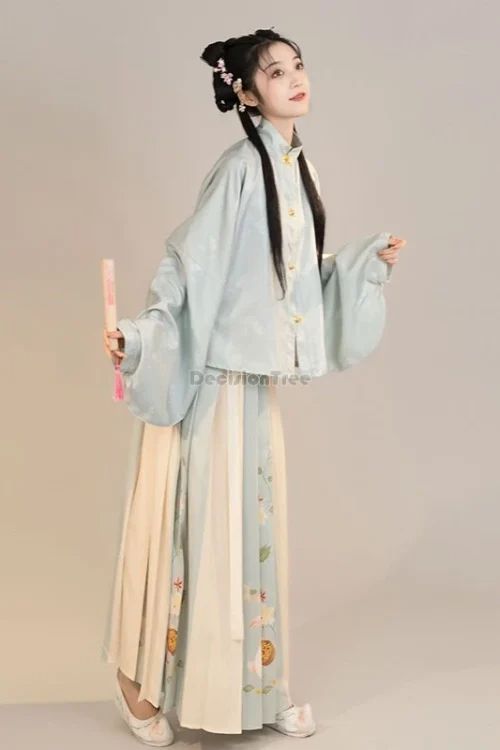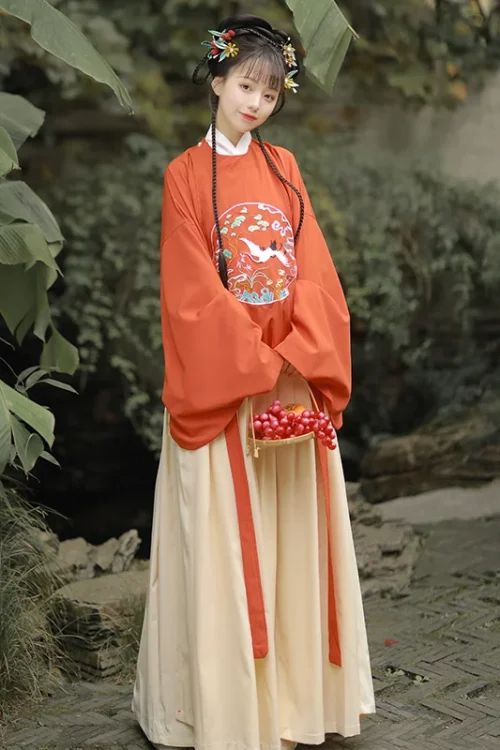The Resurgence of 明代汉服: A Symbol of Cultural Identity
In the tapestry of Chinese history, the Ming Dynasty stands as a vibrant thread, renowned for its cultural achievements and artistic brilliance. Among its many legacies, the Ming Dynasty Hanfu, a traditional form of clothing, has experienced a remarkable resurgence in recent years, captivating the hearts and minds of a new generation.

The Essence of Chinese Aesthetics
The Hanfu, with its flowing robes, intricate embroidery, and elegant silhouettes, embodies the essence of Chinese aesthetics. Its revival is not merely a fashion trend but a profound expression of cultural identity. In an era of globalization and cultural homogenization, the Hanfu serves as a beacon of Chinese heritage, connecting the present to the past.
Factors Driving the Resurgence
The resurgence of the Hanfu can be attributed to several factors. Firstly, there has been a growing awareness of traditional Chinese culture among young people. Social media platforms and online communities have played a pivotal role in fostering this interest, providing a space for enthusiasts to share their knowledge and passion.
A Symbol of National Pride
Secondly, the Hanfu has become a symbol of national pride. In a world where China is increasingly asserting its place on the global stage, the Hanfu represents a tangible connection to the country’s rich history and cultural heritage. Wearing the Hanfu is seen as a way to honor one’s ancestors and express a sense of belonging to the Chinese nation.
Artistic Expression and Modernity
Moreover, the Hanfu has gained popularity as a form of artistic expression. Contemporary designers have reimagined the traditional Hanfu, incorporating modern elements and innovative fabrics. The result is a vibrant and eclectic range of Hanfu that appeals to a wide audience, from fashion enthusiasts to cultural historians.
Challenges of Revival
The revival of the Ming Dynasty Hanfu is not without its challenges. Some critics argue that it is a form of cultural appropriation, while others question its authenticity. However, the vast majority of Hanfu enthusiasts are deeply respectful of the tradition and strive to preserve its integrity.
Ensuring Sustainable Revival
As the Hanfu continues to gain popularity, it is important to ensure that its revival is sustainable and respectful of its cultural significance. By promoting education and fostering dialogue, we can create a vibrant and inclusive community that celebrates the beauty and diversity of Chinese culture.
结论
In conclusion, the resurgence of the Ming Dynasty Hanfu is a testament to the enduring power of tradition. It is a symbol of cultural identity, national pride, and artistic expression. As we navigate the complexities of the modern world, the Hanfu serves as a reminder of our rich heritage and inspires us to embrace our cultural roots.
Hanfu in the Modern Era: Fashion, Identity, and Cultural Expression
In the tapestry of Chinese history, the Ming Dynasty stands out as an era of cultural and artistic brilliance. Among its many legacies, the exquisite Hanfu, the traditional clothing of the Han Chinese, has experienced a remarkable resurgence in popularity in recent times.

A Profound Expression of Cultural Identity
The revival of Ming Dynasty Hanfu is not merely a fashion trend but a profound expression of cultural identity and heritage. In a rapidly modernizing China, where Western influences have become pervasive, Hanfu offers a tangible connection to the nation’s past. By donning these garments, individuals reclaim a sense of belonging and continuity with their ancestors.
Contemporary Appeal
The contemporary appeal of Ming Dynasty Hanfu extends beyond its historical significance. Its intricate designs, vibrant colors, and flowing fabrics have captivated fashion enthusiasts worldwide. Designers have reinterpreted traditional patterns and silhouettes to create modern and stylish interpretations that cater to diverse tastes.
Cultural Pride and Self-Expression
Moreover, Hanfu has become a symbol of cultural pride and self-expression. In a society where conformity often prevails, wearing Hanfu allows individuals to assert their individuality and embrace their unique heritage. It has fostered a sense of community among enthusiasts who gather at cultural events and online forums to share their passion for this ancient art form.
Preservation of Traditional Craftsmanship
The revival of Ming Dynasty Hanfu has also had a positive impact on the preservation of traditional Chinese craftsmanship. Skilled artisans have dedicated themselves to mastering the techniques of Hanfu making, ensuring that this cultural treasure is passed down to future generations.
Cultural Exchange and Global Dialogue
Furthermore, Hanfu has become a catalyst for cultural exchange and dialogue. As its popularity spreads beyond China, it has sparked interest in Chinese history, philosophy, and aesthetics. It has fostered a greater appreciation for the richness and diversity of Chinese culture on a global scale.
结论
In conclusion, the contemporary appeal of Ming Dynasty Hanfu is a testament to the enduring power of tradition. It represents a longing for cultural connection, a celebration of artistic heritage, and a vibrant expression of identity. As Hanfu continues to captivate hearts and minds, it serves as a reminder of the enduring legacy of Chinese civilization and its relevance in the modern world.
Reviving Tradition through 汉服: Preserving Chinese Heritage in a Contemporary World
In the tapestry of Chinese history, the Ming Dynasty stands as a vibrant thread, renowned for its cultural achievements and artistic brilliance. Among its many legacies, the Hanfu, the traditional attire of the Ming era, has experienced a remarkable resurgence in recent years, captivating the hearts and minds of a new generation.

A Tangible Link to the Past
The Hanfu, with its flowing robes, intricate embroidery, and elegant silhouettes, embodies the essence of Chinese aesthetics. Its revival is not merely a fashion trend but a profound expression of cultural identity and heritage preservation. In a rapidly modernizing world, the Hanfu serves as a tangible link to the past, connecting contemporary Chinese with their ancestors.
Growing Appreciation for Traditional Culture
The resurgence of Hanfu is driven by a growing appreciation for traditional Chinese culture. As China’s global influence expands, there is a renewed interest in exploring and celebrating its rich history. The Hanfu, as a symbol of Chinese civilization, has become a focal point of this cultural revival.
Role of Social Media
Moreover, the Hanfu movement has gained momentum through social media and online communities. Enthusiasts share their passion for Hanfu, showcasing its beauty and versatility. This digital platform has fostered a sense of belonging and community among Hanfu enthusiasts, further fueling its popularity.
Fashion Designers and Global Attention
The contemporary appeal of Hanfu extends beyond its cultural significance. Its intricate designs and flowing fabrics have captured the attention of fashion designers and enthusiasts worldwide. Hanfu elements have been incorporated into modern clothing, accessories, and even haute couture collections. This fusion of tradition and modernity has created a unique and captivating aesthetic that resonates with a global audience.
Challenges of Revival
The revival of Hanfu is not without its challenges. Some critics argue that it is a form of cultural appropriation or that it promotes a narrow and idealized view of Chinese history. However, proponents of Hanfu emphasize its role in preserving cultural heritage and fostering a sense of national pride.
Balancing Authenticity and Innovation
As the Hanfu movement continues to grow, it is essential to strike a balance between authenticity and innovation. While preserving the traditional forms and techniques of Hanfu is crucial, it is equally important to adapt it to the needs and sensibilities of contemporary society. By embracing both tradition and modernity, the Hanfu can continue to thrive as a vibrant expression of Chinese culture in the 21st century.
